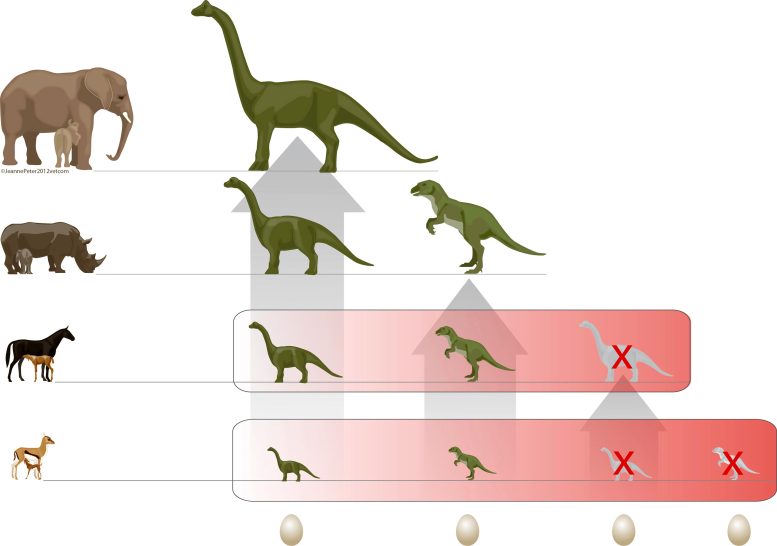
Why there were no small dinosaurs: While mammals occupied the various ecological niches with different species (left), the egg-laying dinosaurs occupied the same niches with few large species – in their respective different growth stages (right). Consequently, there was no room in the niche for smaller and medium-sized species (far right). The absence of species in the smaller and medium size range proved disastrous for them during the mass extinction as it obliterated all the large species and there were not enough small species of dinosaur that could have reoccupied the vacant niches. Credit: Illustration: Universität Zürich; Jeanne Peter
In a published study, scientists from the University of Zurich and Zoological Society of London describe how they believe the reproductive cycle of egg laying put dinosaurs at a disadvantage and helped lead to their extinction.
They laid eggs, occupied many ecological niches with only one species, and competed with one another. Researchers from the University of Zurich have uncovered the chain of events that led to the extinction of the dinosaurs.
Their reproductive strategy spelled the beginning of the end: The fact that dinosaurs laid eggs put them at a considerable disadvantage compared to viviparous mammals. Together with colleagues from the Zoological Society of London, Daryl Codron and Marcus Clauss from the University of Zurich investigated and published why and how this ultimately led to the extinction of the dinosaurs in the journal Biology Letters.
The dinosaur’s egg and the tiny dino baby
Weighing in at four tons, the mother animal was 2,500 times heavier than its newly hatched dinosaur baby. By way of comparison, a mother elephant, which is just as heavy, only weighs 22 times as much as its newborn calf. In other words, neonates are already big in large mammal species. The staggering difference in size between newly hatched dinosaurs and their parents was down to the fact that there are limits to the size eggs can become: After all, larger eggs require a thicker shell, and as the embryo also needs to be supplied with oxygen through this shell, eventually neither the shell nor the egg can grow any more. Consequently, newly hatched dinosaur babies cannot be larger in the same way as in larger species of mammal.
Many species occupy one niche each; one species occupies many niches
In addition, newborn mammals occupy the same ecological niche as their parents: As they are fed with milk directly by the mother, they do not take any niche away from smaller species. With large dinosaurs, however, it was an entirely different story: They did not only occupy the adults’ one niche during their lifetime, but also had many of their own to pass through – from niches for animals with a body size of a few kilos and those for ten, 100 and 1,000-kilo animals to those that were occupied by the fully grown forms of over 30,000 kilograms (66,000 pounds).
Daryl Codron explains what this means for biodiversity: “The consensus among researchers is that animals of particular body sizes occupy particular niches. In the case of the dinosaurs, this would mean that a single species occupied the majority of the ecological niches while mammals occupied these through numerous species of different sizes.” Accordingly, the research results reveal that dinosaurs of a small and medium body size were represented with far fewer individual species than was the case in mammals – because their niches were occupied by the young of larger species. “An overview of the body sizes of all dinosaur species – including those of birds, which are also dinosaurs after all – reveals that few species existed with adults weighing between two and sixty kilograms,” specifies Codron. And Marcus Clauss sums up the consequences of this demonstrated by the researchers using computer simulations: “Firstly, this absence of small and medium-sized species was due to the competition among the dinosaurs; in mammals, there was no such gap. Secondly, in the presence of large dinosaurs and the ubiquitous competition from their young, mammals did not develop large species themselves.” The third insight that the computer simulation illustrates concerns small dinosaurs: They were in competition both among their own ranks and with small mammals. And this increased pressure brought the small dinosaurs either to the brink of extinction or forced them to conquer new niches. The latter enabled them to guarantee their survival up to the present day, as Codron concludes, since “back then, they had to take to the air as birds”.
The catastrophe: The small dinosaurs take to the air and the large ones die out
The dinosaurs’ supremacy as the largest land animals remained intact for 150 million years. The mass extinction at the Cretaceous-Tertiary boundary, however, spelled trouble as the species gap in the medium size range turned out to be disastrous for them. According to the current level of knowledge, all the larger animals with a body weight from approximately ten to 25 kilos died out. Mammals had many species below this threshold, from which larger species were able to develop after the calamity and occupy the empty niches again. The dinosaurs, however, lacked the species that would have been able to reoccupy the vacant niches. That was their undoing.
Reference: “Ontogenetic niche shifts in dinosaurs influenced size, diversity and extinction in terrestrial vertebrates” by Daryl Codron, Chris Carbone, Dennis W. H. Müller
and Marcus Clauss, 18 April 2012, Biology Letters.
DOI: 10.1098/rsbl.2012.0240

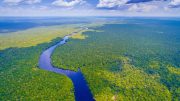
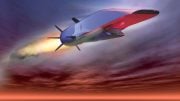
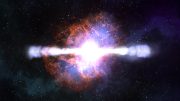


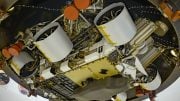


Be the first to comment on "Reproductive Cycle Put Dinosaurs at a Disadvantage"